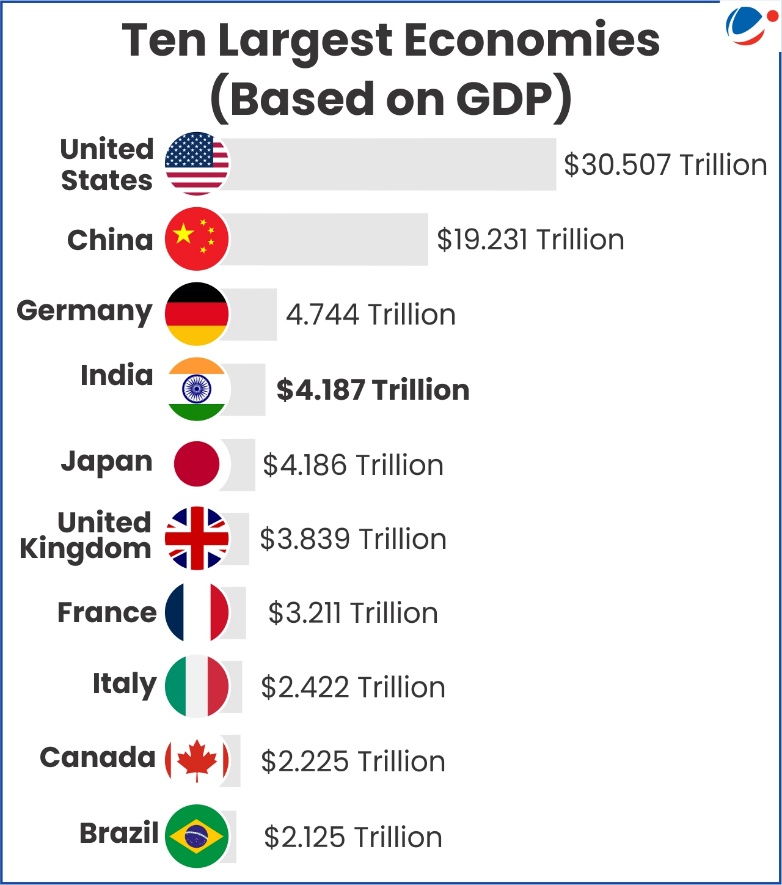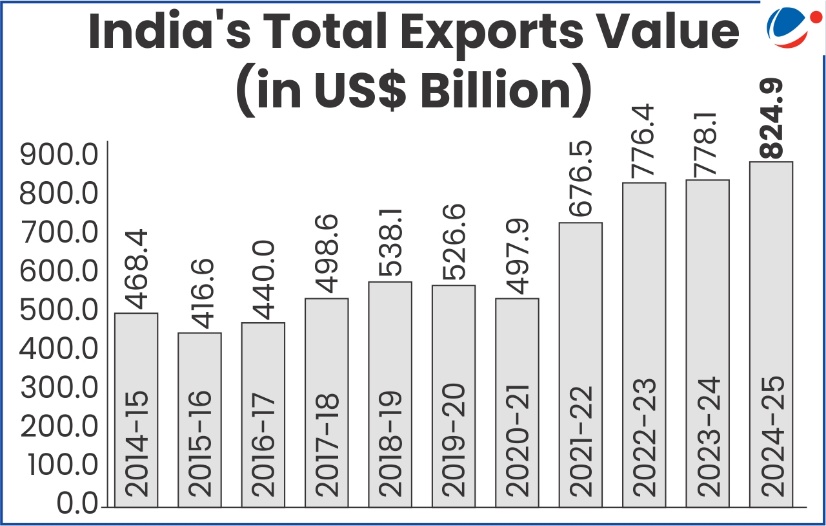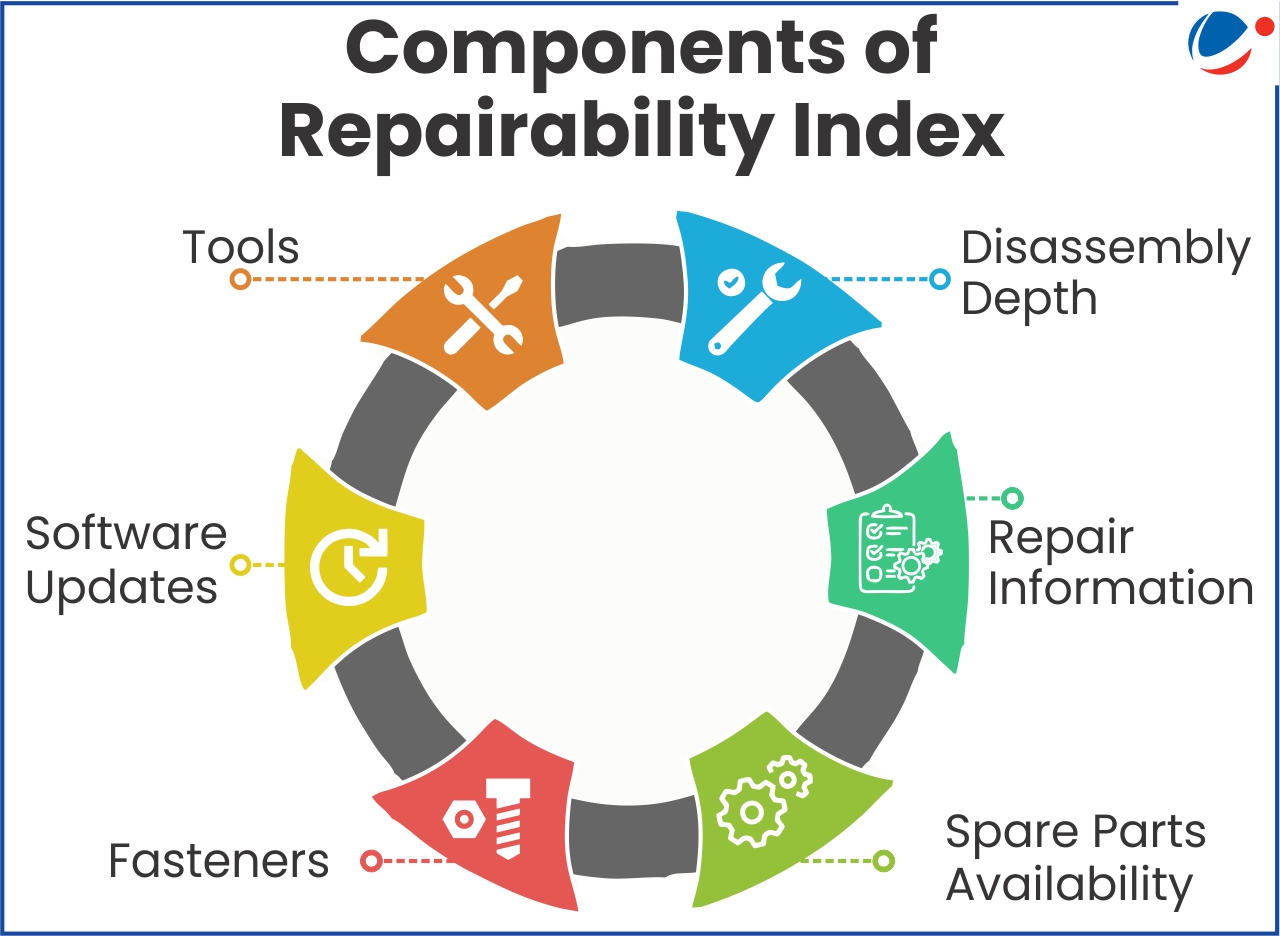India Overtakes Japan to Become 4th Largest Economy

As per the recent World Economic Outlook of the IMF, India has surpassed Japan to become 4th largest economy worldwide.
Key drivers for India’s Economic Leap
- Structural: Urbanization and rising aspirations leading to rise in per capita income and lifestyle consumption, demographic dividend (India’s current median age is ~29 years), strong domestic demand (private consumption contributes nearly 70% to GDP), etc.
- Policy: Taxation and business reforms (implementation of GST, IBC, Corporate Tax cuts, etc.), push for infrastructure (National Infrastructure Pipeline, PM Gati Shakti, etc.), Atmanirbhar Bharat and Production-linked incentive, etc.
- Technological: Digital Public Infrastructure (UPI, JAM Trinity, etc.), strong global demand for Indian IT, software exports, and consulting services, etc.
- External and global factors: Increased FDI inflows, Global supply chain rebalancing with strategies like ‘China Plus One’ and Supply Chain Resilience Initiative, etc.
Future prospects for the Indian Economy
India is well positioned to become 3rd largest economy in the coming 2.5 to 3 years due to factors like:
- Energy transition: Rapid growth in renewable energy capacity (targeting 500 GW by 2030) and leadership in global platforms like the International Solar Alliance (ISA) positions India as a green growth leader.
- Regulatory stability: Reforms in banking sector (e.g., bank recapitalization) and strong regulatory institutions like RBI ensure macroeconomic stability.
- Tags :
- 4th Largest Economy
India Achieves Highest Ever Exports
As per the RBI, India’s total exports (Merchandise + Services) have reached $824.9 billion in 2024-25 rising by 6.01 % from $778.1 billion in 2023–24.

- This is despite global slowdown triggered by trade disruptions due to Red Sea crisis, Ukraine war, drought in Panama Canal, increase in Non-Tariff Measures, rising energy prices etc.
Key data and trends
- Merchandise Exports: Have marginally increased to US$437.4 billion, from US$437.1 billion in 2023-24.
- Services Exports: Reached a historic high of US$387.5 billion in 2024–25, up 13.6% from US$341.1 billion in 2023-24.
- Key sectors included telecommunications, computer and information services, transport, travel, and financial services.
Factors Driving Export Growth
- Policy Push: Government boosted exports via New Foreign Trade Policy, sector-specific schemes, Trade Facilitation, Districts as Export Hubs Initiatives and MSME support.
- Diversification of export markets: Rising demand from Southeast Asia, Africa, and Latin America offset global slowdowns.
- Trade Agreements: New bilateral and multilateral deals, such as India-UAE Comprehensive Economic Partnership Agreement (CEPA), opened markets and lowered barriers, particularly for services and electronics.
- Supply Chain Realignment: India became a reliable alternative in China-plus-one strategies, attracting global companies.
- Tags :
- India's Exports
Articles Sources
Repairability Index

Committee formed under chairmanship of Bharat Khera to develop a framework for a Repairability Index (RI) in mobile and electronic sector has submitted its report to Department of Consumer Affairs (DoCA).
About RI Framework (Recommended by Committee):
- Original Equipment Manufacturers (OEMs) are required to self-declare RI based on standards scoring criteria provided in framework.
- RI should be displayed at point of sale/purchase, E-commerce platforms and in form of QR code on packaged products.
- Committee identified smartphones and tablets as priority categories for the initial phase of RI.
- RI is assessed on six core parameters (Refer Infographic).
- Scoring criteria and weightages were developed for each parameter.
- A RI on a five-point numeric scale is calculated after aggregating weightages for priority parts.
Significance of RI:
- Improved repair accessibility: There has been significant rise in complaints in mobiles and tablets product category from 19,057 in 2022-2023 and further to 22,864 in 2024-2025.
- Promoting Sustainable Economy: RI emphasizes on LiFE (Lifestyle for the Environment) movement through Promoting sustainable consumption.
- Address issue of ‘planned obsolescence’: i.e. devices are designed specifically to last a limited amount of time and to be replaced.
- Employment generation: By allowing third-party repairs.
About Right to Repair:
- It calls for companies to make spare parts, tools and information on how to repair devices available to customers and repair shops to increase lifespan of products.
- DoCA launched Right to Repair Portal India in 2022, to facilitate relevant repair associated information.
- Tags :
- repairability index
World Audio Visual and Entertainment Summit (WAVES), 2025
At the inaugural WAVES Summit 2025 in Mumbai, Prime Minister highlighted the India’s creative economy as a powerful driver of future GDP growth, innovation, and inclusive development.
- WAVES aims to unlock a $50 billion market by 2029, positioning India as a major player in the global entertainment economy.
- During the summit, government announced the launch of the Indian Institute of Creative Technology (IICT) for the creative sector.
- It is being established by Ministry of Information and Broadcasting in strategic partnership with FICCI & CII, envisioned as a National Centre of Excellence.
What is Creative Economy?
- Definition: Creative economy (orange economy) is an evolving concept based on the contribution & potential of creative assets to contribute to economic growth and development.
- It includes Media & Entertainment, Advertising and Marketing, Animation, Visual Effects, Gaming, Comics, and Extended Reality (AVGC-XR) etc.
- The United Nations declared 2021 as the International Year of Creative Economy for Sustainable Development, emphasizing its global importance.
India’s Creative Economy
- Contribution: $30 billion to GDP, employing 8% of the workforce. Creative exports exceed $11 billion annually.
- Challenges: Misinformation, copyright, intellectual property, privacy, and market monopolization, limited rural digital access, and lack of formal financing.

- Tags :
- creative economy
Indian Institute of Creative Technology
Indian Institute of Creative Technology (IICT) has been launched by Ministry of Information and Broadcasting in collaboration with FICCI and CII.
About IICT:
- It will serve as a National Centre of Excellence (NcoE) dedicated exclusively to Animation, Visual Effects, Gaming, Comics, and Extended Reality (AVGC-XR) sector.
- Extended Reality (XR) technologies blend physical and digital worlds e.g. Virtual Reality (VR), Augmented Reality (AR), and Mixed Reality (MR).
- It will follow same template as IITs and IIMs in India to transform itself into a massive world-class education and training hub for students who aspire to be professionals in AVGC-XR sector.
Status of AVGC-XR sector
- Globally AVGC-XR market was valued at over $366 billion in 2021.
- India: Currently accounts for less than 1% of the global market. Indian AVGC-XR market could reach $26 billion by 2030.
- Karnataka, recognized as India’s IT hub, is carving out a leadership position in the AVGC-XR sector.
Emerging key growth drivers of AVGC-XR sector in India
- Growing OTT User base: In 2024, India had an estimated 547 million OTT users, representing a penetration rate of 38.4%.
- Growth of Smartphone Users: India is set to have over 900 million internet users by 2025, with a majority from rural areas, according to the IAMAI and Kantar report.
- Wider Spectrum of Applications: Animation and VFX sector can be used in Gaming, EdTech, Architecture etc.
- Advent of New Technologies: E.g. Investment in AR and VR is increasing year on year.

Other reasons: Increased R&D Investments
- Tags :
- creative technology



